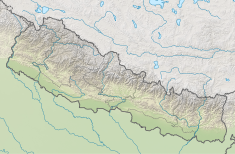| Upper Karnali Hydropower Project | |
|---|---|
| Official name | Upper Karnali Hydropower Project |
| Location | Nepal |
| Coordinates | 28°55′23″N81°28′20″E / 28.92306°N 81.47222°E |
| Status | Proposed |
| Construction began | unknown |
| Opening date | 2024 (est.) |
| Owner(s) | Nepal Electricity Authority |
| Dam and spillways | |
| Type of dam | Gravity |
| Impounds | Karnali River |
| Height | 64 m (210 ft) |
| Length | 207 m (679 ft) |
| Reservoir | |
| Surface area | 1.96 km² |
| Upper Karnali Hydropower Station | |
| Coordinates | 28°54′02″N81°26′40″E / 28.90056°N 81.44444°E |
| Commission date | 2024 (est.) |
| Type | Run-of-the-river |
| Hydraulic head | 159.26 m (522.5 ft) |
| Turbines | 8 x 112.5 MW Francis-type |
| Installed capacity | 900 MW |
The Upper Karnali Storage Hydropower Project is a proposed run-of-the-river hydroelectric plant on the Karnali river in Nepal. It will have an installed capacity of 900 MW, making it the largest hydropower plant in Nepal when achieved. [1] However, most of the generated power is set to be exported to both Bangladesh (about 500 MW) and India (another 292 MW), via a 400 kV double circuit transmission line, with the only remaining 108 MW of total power dedicated to local consumption. [2]
First planned in the 1990s as a smaller-scale 240 MW facility, the current 900 MW design was approved in 2008. A much larger 4,180 MW generation eventuality was identified on the same site during the feasibility studies, but this option was not selected. [3] As of February 2020, the Power Purchase Agreement was hoped to be signed within 3 months, which might give a boost to the long-delayed project. [4]
The expected cost of the dam is US$1.5 billion, partly funded by the Asian Development Bank, and its construction should employ an estimated 3,000 workers during 5 years. [2]
